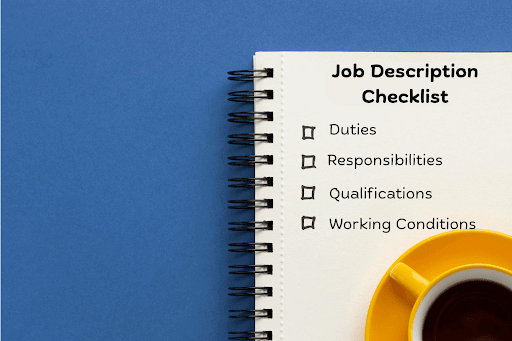Job Description Examples Across Different Industries

What is a Job Description?
Job descriptions are essential tools for defining roles, responsibilities, and qualifications. They help with recruitment, set clear expectations, and support long-term workforce management. A job description typically outlines the purpose of the role, its duties, required skills, and working conditions. Job identification, on the other hand, is a subsection within the job description that provides the key administrative details-such as the job title, department, reporting line, job code, and the date it was created or revised. For example, a job identification entry for a nurse might look like this:
- Job Title: Registered Nurse (ICU)
- Department: Nursing
- Reports To: Nurse Supervisor
- Date: August 2025
Together, job identification and the rest of the job description give both employers and employees a clear understanding of the role.
How to Write a Job Description?
A strong job description balances clarity with detail. Here’s a structured approach:
1. Start with Job Identification
This section anchors the role in the organizational structure. It should include:
- Job Title
- Department or Division
- Reports To (supervisor or manager)
- Job Code (if used)
- Date Created or Revised
2. Write a Clear Job Summary
Keep it concise (2-3 sentences). Capture the role’s overall purpose and primary function. Example: “The Staff Accountant supports financial operations by maintaining ledgers, preparing reconciliations, and assisting in audits to ensure compliance with reporting standards.”
3. List Duties and Responsibilities
Use action-oriented bullet points, starting with strong verbs such as “analyze,” “manage,” or “coordinate.” Keep to 6-10 core duties that cover at least 80-90% of the role. Tips:
- Order responsibilities by importance.
- Avoid vague phrasing like “handle tasks as assigned.”
- Where possible, include scope (e.g., “manages a $50K monthly budget”).
4. Define Qualifications
Separate into required and preferred.
- Required: Education, certifications, years of experience, and technical skills.
- Preferred: Nice-to-have skills that provide an advantage but aren’t mandatory.
5. Add Working Conditions
Specify location, schedule, travel, physical demands, or environmental factors (e.g., hospital setting, office-based, shift work).
6. Keep It Inclusive and Accessible
Avoid jargon, biased language, or unnecessary requirements that may discourage qualified candidates. For companies looking to refine descriptions and improve hiring strategies, services like recruitment process outsourcing can help streamline the process.
Job Description Examples by Industry
Here are four real job description examples to show how they vary by field:
Healthcare: Registered Nurse (ICU)
Job Description Example:
- Summary:
Provides patient-centered care in the Intensive Care Unit, ensuring adherence to hospital protocols and medical best practices. - Responsibilities:
- Monitor and document patient vital signs.
- Administer prescribed medications and treatments.
- Collaborate with doctors to execute treatment plans.
- Educate patients’ families on care and recovery processes.
- Qualifications:
- Required: Bachelor of Science in Nursing, valid RN license.
- Preferred: ACLS certification, ICU experience.
- Working Conditions:
Hospital-based; 12-hour rotating shifts, exposure to high-pressure medical situations.
Accounting: Staff Accountant
Job Description Example:
- Summary:
Supports financial operations by preparing journal entries, reconciling accounts, and ensuring compliance with accounting standards. - Responsibilities:
- Maintain general ledgers and financial records.
- Assist in month-end and year-end closing processes.
- Prepare financial statements and reports.
- Collaborate with auditors during annual audits.
- Qualifications:
- Required: Bachelor’s degree in Accounting or Finance, proficiency with ERP systems.
- Preferred: CPA certification, 2+ years in corporate accounting.
- Working Conditions:
Office-based, with peak workloads during fiscal year-end.
Legal: Paralegal
Job Description Example:
- Summary:
Provides legal support to attorneys through research, drafting, and document management. - Responsibilities:
- Draft legal contracts, pleadings, and correspondence.
- Conduct legal research and summarize findings.
- Manage and organize case files.
- Coordinate schedules and prepare trial materials.
- Qualifications:
- Required: Bachelor’s in Legal Studies or equivalent, strong research skills.
- Preferred: Paralegal certification, law firm experience.
- Working Conditions:
Office setting; occasional overtime required before trials.
Hospitality: Hotel Front Desk Associate
Job Description Example:
- Summary:
Acts as the first point of contact for guests, ensuring excellent customer service and smooth hotel operations. - Responsibilities:
- Greet guests, process check-ins, and check-outs.
- Handle billing, payments, and room assignments.
- Manage reservations via PMS systems.
- Resolve guest complaints with professionalism.
- Qualifications:
- Required: High school diploma, customer service experience.
- Preferred: Hotel system experience, multilingual ability.
- Working Conditions:
Shift-based role; nights, weekends, and holidays required.
Why Job Descriptions and Job Identification Matter
Whether in healthcare, accounting, legal, or hospitality, well-written job descriptions provide structure, transparency, and compliance. They not only attract the right candidates but also guide onboarding and long-term employee success. At De Vore Recruiting, we know how important it is to find the right fit. That’s why our team is here to help make your hiring process more effective. With specialized solutions like our Retained Search services, we provide a focused and streamlined approach to connecting you with top talent.
